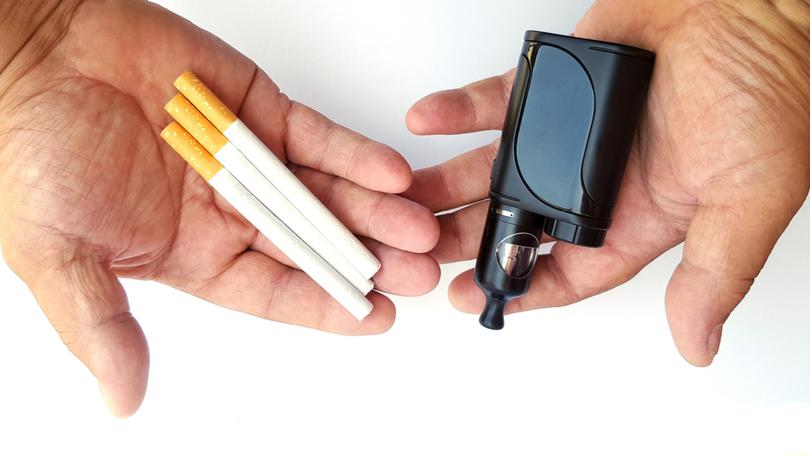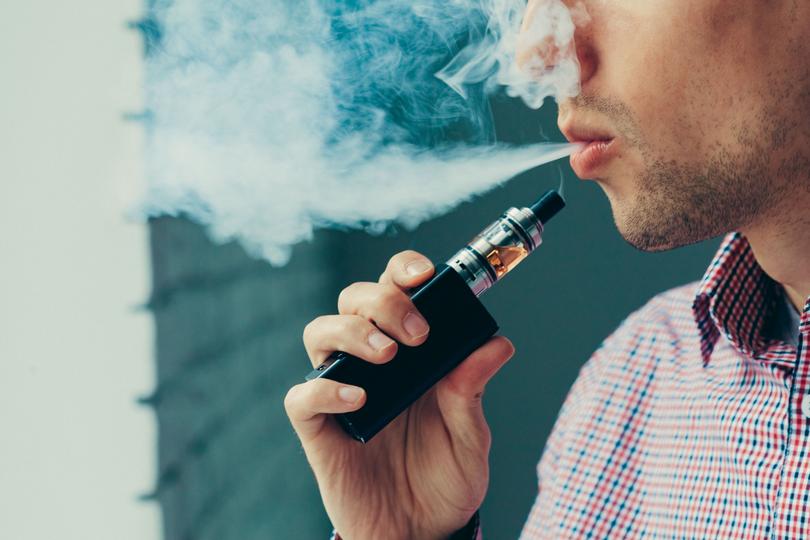Smoking compared with vaping - what both do to your body from the first puff

Back in my 20s, I was a regular “party smoker”, sparking up on a night out with friends, or heading outside for a cheeky fag during a raucous dinner party. Smoking was part of the ritual of going out, whether it was having “pre-drinks” with friends or lighting up after the first pint; there was something releasing about the heady rush of the first inhale; the satisfaction of that stream of smoke that made the inevitably worse hangover of the next day worth it.
I stopped after I had children and for years after, although last summer, juggling job changes and house moves, I briefly started up again (call it a midlife crisis). I came to my senses in the autumn after realising I didn’t, actually, like the way smoking made me feel; I haven’t touched one since. I’ve never bothered with vapes: sucking away on a piece of plastic has never seemed that appealing (so undignified!), so I can’t compare the two, but friends who’ve switched to vaping can be evangelical about it, not least because they can smoke inside. “The first vape I bought was at an airport, where I couldn’t get cigarettes,” recalls one friend. “The head rush was so strong I practically had to have a lie-down afterwards.”
Can vaping really be less harmful than smoking? The harms associated with smoking tobacco are indisputable: more than 75,000 people a year die in the UK as a result, and two out of three smokers will die from a smoking-related disease. Doctors are almost universally reluctant to condemn vaping. Vaping is, says Prof Sanjay Agrawal, the Royal College of Physicians’ special adviser on tobacco, “significantly less harmful than smoking, but it is still not risk-free”.
Sign up to The Nightly's newsletters.
Get the first look at the digital newspaper, curated daily stories and breaking headlines delivered to your inbox.
By continuing you agree to our Terms and Privacy Policy.As with smoking, it’s the method by which the nicotine enters the body that causes the problem: with cigarettes, it’s the carbon monoxide and tar produced by the burning tobacco, while in a vape, the chemical reaction between the liquid and metal leads to the release of toxic metals including arsenic, chromium, nickel, formaldehyde and lead. Both are also very bad for your teeth.
Then there’s the addiction issue. The average cigarette contains around 12mg of nicotine; Elf Bars – among the most commonly used disposable vapes in the UK – contain 20mg of nicotine per 2ml of liquid, equating to around 40-50 cigarettes’ worth in fewer than 600 puffs, and while nicotine in and of itself is not hugely harmful (it’s a stimulant like caffeine), it’s highly addictive.
Maybe that’s partly why vape use has soared: a recent study found that from January 2021 to August 2023, the prevalence of disposable e-cigarette use grew from 0.1 per cent to 4.9 per cent of the adult population. More alarmingly, 14.4 per cent of 18- to 24-year-olds use disposable vapes, and there was a rise of 7.6 per cent in vape use in children aged 11-17, despite it being illegal to sell vapes to under-18s.

While vaping is “much, much safer” than smoking, says Prof Nick Hopkinson of the National Heart and Lung Institute at Imperial College, he acknowledges the increased risks for young people. “It’s likely that chemicals in the vape over decades is going to cause lung disease,” he says; and when lungs are growing and developing they are “probably more vulnerable to this”.
There have been, he says, rare examples of chronic allergic reactions to vapes (in 2019, a patient in Illinois was admitted to hospital “with unexplained illness after reported vaping” and is thought to have died of injuries caused by the lungs’ reaction to a caustic substance), but he says one of the biggest problems with vaping is around behaviour: vapes are so addictive that the cycle of craving and reward can be incredibly disruptive.
While there are years of data on the effects of smoking, that doesn’t exist for vaping, so it’s difficult to exactly compare the long-term effects. But what do we really know about what the two actually do to your body?
When you take the first puff
Smoking
“As soon as you inhale the smoke, the cells in the lining of your lungs and the alveoli, the very fragile air sacs in your lungs, are exposed to a series of toxic chemicals,” says Prof Hopkinson. These trigger inflammation and stress, activating the white blood cells. The cilia – hairs in your throat that help to catch bacteria – will also be damaged by the passage of the smoke, and the goblet cells scattered throughout them will start to produce mucus.
Vaping
The first suck triggers a battery-powered electric current to heat up a coil of thin wire which is saturated with liquid containing nicotine and other chemicals, including flavourings. The hot liquid converts to vapour which, as you inhale it, passes through the lungs to enter the bloodstream, increasing the heart rate and blood pressure; the lining of the nose and throat will also become irritated from the chemicals being inhaled. A 2019 Harvard study found that two chemicals widely used to flavour e-cigarettes might also be having an impact on the function of cilia, just as cigarettes do.
In both cases, the nicotine will bind to proteins in the brain within 11 seconds, triggering the release of dopamine and serotonin, which is what gives you that head rush. And both increase your risk of lung cancer from the first puff.
After a few minutes
Smoking
The reaction of the white blood cells will start to change the lining of the lungs, which will produce more mucus. You will also be getting a big dose of carbon monoxide at this point, which affects the delivery of oxygen to the lungs and other organs, damaging muscles and blood vessels and making you cough. The nicotine in the cigarette – a mild stimulant – will cause the blood vessels to constrict, and will also start to make you feel more lively.
Vaping
The nicotine will be kicking in properly, giving you a similar increased heart rate and blood pressure as a dose of caffeine, exercise or excitement. A 2021 American study found vapers had significantly higher heart rate, breathing frequency and mouth temperature, and significantly lower blood oxygenation levels after vaping for 20 minutes.
Within half an hour of smoking both cigarettes and vapes, cells experience oxidative stress, which can cause fatigue, brain fog, muscle pain and headaches.
An hour later
Smoking
“Nicotine and carbon monoxide will remain high in the blood for up to 48 hours,” says endocrinologist Dr Gareth Nye from the University of Chester. “This will limit your ability to transport oxygen around the body, which limits your ability to do physical activity.” The white blood cells will be trying to remove the tar particles from the cigarette and ingest them, which will effectively make them “angrier” or more activated. The digestive enzymes will also be activated to try to break down those particles; together, they will start to damage the lining of the lung.
Vaping
The body will start to metabolise the nicotine, decreasing its concentration in the bloodstream and so giving you a craving for more. After an hour or so, your body will also start to suffer endothelial cell dysfunction, stopping the large blood vessels opening properly.
After a week
Smoking
The same thing happens every time you light up, but it takes a certain amount of exposure for chronic change to your body, although at this point you’ll probably start to notice changes to your teeth (which will get yellower), gums and lips (which will become inflamed) and skin (which will get drier). Some of that damage is reversible – if you stop smoking, for example, the carbon monoxide within your body will be gone within 24 hours.
Vaping
The cardiovascular system will constantly be being altered, meaning the blood vessels will start to harden and get stiffer.
After a month
Smoking
A month of smoking will see accumulated damage to the lungs, with airways and blood vessels accruing damage over time. The DNA damage that leads to the onset of cancer will also be kicking in at this point. Your sense of taste and smell will also be affected.
Vaping
Vaping consistently for a month can cause lung inflammation, due to nanoparticles from the vapour becoming embedded in the lungs; this will be worse if you use a flavoured vape.
Depending on your age and when you started vaping, your alveoli will also start to become scarred.
After a year
Smoking
It’s likely you’ll start showing signs of gum disease, although, says dentist Dr Sam Jethwa, “you can’t always identify it until you have an assessment and X-rays, because you won’t get the usual signs of bleeding and inflamed gums because the gums will have shrunk.” You may also be experiencing a decrease in fertility and, for men, sexual performance.
Vaping
One study found that people who vaped for at least six months had high levels of inflammation, mouth wounds and up to a 100-fold increase in oral fungi. A paper published in the American Journal of Preventive Medicine tracked vapers for three years and found they had a 1.3-times higher risk of developing respiratory disease, such as lung disease, than people who did not use any tobacco product.
Stroke and cardiovascular risk increase with prolonged cigarette smoking and vaping, while nicotine can have an impact on brain development in young people.
After 20 years
Smoking
Every organ and organ system in your body will have been damaged at this point. You’ll be at increased risk of heart disease, emphysema, stroke, leukaemia, asthma, pneumonia and TB, and your overall cancer risk will have increased substantially. Even if you’re just a social smoker (smoking fewer than 10 cigarettes a day), a 17-year long study by Columbia University found the risk of lung cancer death is not substantially lower than for those who smoke more than 20 a day. You will also have lost bone in your jaw, so your teeth may have started to loosen and fall out.
Vaping
There’s no long-term data on the effects of vaping, so it’s difficult to quantify. The biomarkers of exposure show changes to blood vessel function and lung damage. “Heavy metals that are highly present in vaping aerosols, such as chromium, copper and aluminium, are reported to disrupt several cellular processes, such as aerobic respiration, resulting in ROS [reactive oxygen species] production and oxidative stress,” says Dr Nye.
“Away from the lungs, there is growing evidence that the metal particles [from a vape] can enter the bloodstream and lead to fundamental changes to the heart function and cardiovascular responses.” It’s likely your periodontal health will have been affected: vaping decreases saliva production, a known cause of cavities, and if you smoke flavoured vapes, the sugar and flavouring will also have damaged your teeth; a recent study showed vapers are around 2-2.5 times more likely to develop oral cancers than non-users.
This article first appeared in The Telegraph.
